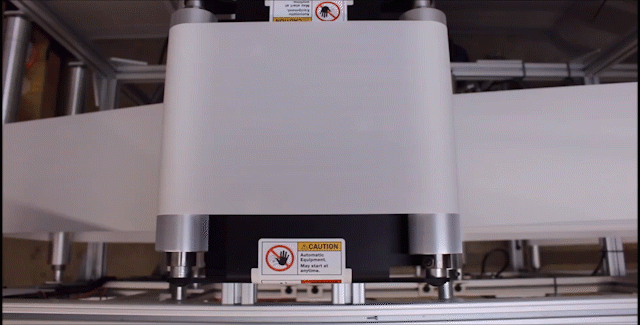Most web guides work on the fundamental principle of Normal Entry.
This rule states that a web approaching a roller will align itself perpendicular to the axis of rotation of the roller. The Normal Entry principle accounts for one of the most common defects in a converting line, roller misalignment. If your converting line has one roller that is not correctly aligned perpendicularly to the required path of the web, the web will move in order to be perpendicular to the misaligned roller. After that position, the web will then be at a location that is probably not the desired location. It will require correction by an alignment system.
Web guides are based on the effects of roller misalignment
In a sense, roller misalignment is used to correct Web guides that align the material using the same normal entry principle. By deliberately changing the axis of rotation of the guide roller, the web guides steer to a different position. Several types of web guides are used to align the web; the difference is in the way the axis of rotation of the roller is changed.
The web is like a beam.
When the web is subject to a change in the axis of rotation of the roller, the web behaves like a beam. The angular displacement of the roller axis bends the beam, and this bending force causes the web to move on the roll until it is perpendicular to the axis of rotation of the roller. Jerry Brown created a video that represents very well this principle:
However, there are dynamic factors that will affect how the web moves such as speed of the web, tension, web material and friction between the surface of the web and the roller in order for the normal entry principle to have an effect. For example, if the web is able to slip on the surface of the rollers, the web would completely slip off both rollers as it tries to achieve a perpendicular position to the misaligned roller axis of rotation. As you could see in the previous video, the web moved up on the misaligned roller until it achieved its final position perpendicular to the axis of rotation of the displaced roller. At this steady state you notice that the web remained in position in the fixed roller upstream as it has enough traction to avoid any movement on the surface of the roller. The web is subject to bending, and as a beam, it is subject to stresses due to the bending. You will have a tight side and a slack side and there will be a tension profile through the web due to the bending of the beam or web.

Many intermediate web guides depend on this principle to properly align the web with the process. So, it is important to understand this principle to help you understand how a web guide works.
In future blogs we will go into more detail on web guiding systems and the dynamics.
We invite you to sign up to receive information on web guiding and web monitoring. There are many exciting developments that will come up this year that your operation will benefit from.
